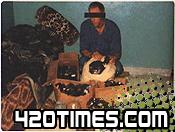SpeesCees
Well-Known Member
Cannabis D'Indica
- One of the most talked about plants on earth. 'Used' on a large scale - and usable for many things -

This page is not intended for experienced growers; they already 'know all this since long'. This page is intended as information for the ordinary grower and smoker. In clear language, without difficult formulas, details or 'highspeak'. This page is meant to bring us a little closer towards the soul of the plant, no more and no less! The plant as it exists nowadays can be very confusing; Indica, Sativa, Ruderalis, hemp, marijuana, weed, Skunk etc. Quite some names indeed for one single plant! Yes, all these names refer to something, but it's more important to become aware of the origins of that plant, and once discovered those, to take a look at the details. Are you coming along?
Cannabis has a history that can be traced back very long, through many different cultures. Nevertheless there is only one place where the plant was found originally. The plant that got us so enthusiastic, Cannabis D'Indica, is indigenous in roughly the territory of North-western India. You should realise that on very old maps of India this territory was much larger than it is nowadays, including some Himalaya states which now no longer exist, so we can safely assume that on the Southern flanks of the mountainrange cannabis was also found. Here we find the natural habitat of the plant, the place where it could reproduce itself naturally. As a matter of fact, all the other cannabis plants in the world (apart from subspecies) are Sativa's. If you take seeds from India and grow plants from them, it's amazing how readily these plants adapt themselves to their new environment. Through the centuries whole cultures of cannabis have appeared on the other continents, very often typical Sativa's, well adapted to their environment.
But the original plant is the Cannabis D'Indica and originates in the ancient North-west of India. Indica's can be recognised by their deep, green colour and the broad, overlapping 'fingers' in their leaves. For example Kush and Afghan plants are clear and pure Indica's. K2, White Widow and Northern Light plants look strongly like Indica's, but are crossed, so they are Sativa's. But uhhh… I'm getting carried away, and besides, I'm not a botanist. Let me take you to the land of how, where and why!!
So much rubbish is being told about this plant that I can't resist the temptation of being an authentic wiseguy here…
The plant was found in a territory where it's extremely hot during the day and cools down dramatically during the night. These differences can be quite extreme in these mountains. If we take a good look at these plants and consider how they survive and reproduce, you'll find some awesome and ingenious tricks of nature. That they turn out to be very pleasant for us, is quite a bonus of course! Very early in it's vegetative stage the plant, especially the females, develop a number of glands that cannot be counted with the bare eye. When you hold the plant against the sunlight you'll be able to see them. They look like millions of little hairs, but in fact they're all glands.
In that gland the resin is produced that has to protect the plant, the flowers, and most important of all, the seeds. A coating of resin emanating from the glands concentrates around the most sensitive areas, such as the flowers and seed lobes. This resin prevents the plant from dehydrating during the day; the sun causes the resin to get syrupy, so the resinous substance we know in a concentrated form as hash, flows all over the buds. At night it turns very cold and the resin gets hard, thus protecting the plant from cold. During the day, in the hot sun, the resin starts flowing again and continues to protect the plant… The lump of resin in which the 'wild' seeds are enveloped when they drop from the plant, takes care of protecting the seeds until the next spring. Clever little plant, isn't it!?
If you take a look at other cultures, you'll find a completely different story. In Morocco, for example, you can sieve the resin from the plants so easily because the climate there causes the plant to act differently. In these parts it's not as cold at night, nor is it as hot during daytime. The temperature differences aren't that extreme, apart from the fact that we are dealing with a different environment and duration of the cycle. Here the resin doesn't flow out and cover the buds, but remains sticking to the gland as a droplet. After drying, this droplet readily drops off and is easily sieved. The dry powder is not as dry as it seems at first, as becomes apparent when you start pressing. By heating and pressing the cell walls of the dried resin break, everything flows together as a result of the heat and pressure applied, and the result is a compact mass we call hash.
Well yes, the resin contains a certain percentage of THC. Sometimes much, sometimes little. The point is, that smoking the resin results in a high or stoned effect, which can be very pleasant and mind-expanding. Medicinally good instead of criminal goods! But uhh… you don't get stoned from THC!!! The antibodies your body produce against the invading substances (most of all THC) make you high or stoned! So literally speaking, it's not the THC that is responsible for these effects!! This also explains why most people who smoke for the first time hardly ever notice anything; the body simply doesn't recognise the substance and doesn't yet produce the antibodies… But you better try some good pot, and uhhh…. Welcome to the club!!!!
Stay cool, high and take time to fly
SpeesCees (Mr. XX.) / No Mercy Seeds
- One of the most talked about plants on earth. 'Used' on a large scale - and usable for many things -

This page is not intended for experienced growers; they already 'know all this since long'. This page is intended as information for the ordinary grower and smoker. In clear language, without difficult formulas, details or 'highspeak'. This page is meant to bring us a little closer towards the soul of the plant, no more and no less! The plant as it exists nowadays can be very confusing; Indica, Sativa, Ruderalis, hemp, marijuana, weed, Skunk etc. Quite some names indeed for one single plant! Yes, all these names refer to something, but it's more important to become aware of the origins of that plant, and once discovered those, to take a look at the details. Are you coming along?
Cannabis has a history that can be traced back very long, through many different cultures. Nevertheless there is only one place where the plant was found originally. The plant that got us so enthusiastic, Cannabis D'Indica, is indigenous in roughly the territory of North-western India. You should realise that on very old maps of India this territory was much larger than it is nowadays, including some Himalaya states which now no longer exist, so we can safely assume that on the Southern flanks of the mountainrange cannabis was also found. Here we find the natural habitat of the plant, the place where it could reproduce itself naturally. As a matter of fact, all the other cannabis plants in the world (apart from subspecies) are Sativa's. If you take seeds from India and grow plants from them, it's amazing how readily these plants adapt themselves to their new environment. Through the centuries whole cultures of cannabis have appeared on the other continents, very often typical Sativa's, well adapted to their environment.
But the original plant is the Cannabis D'Indica and originates in the ancient North-west of India. Indica's can be recognised by their deep, green colour and the broad, overlapping 'fingers' in their leaves. For example Kush and Afghan plants are clear and pure Indica's. K2, White Widow and Northern Light plants look strongly like Indica's, but are crossed, so they are Sativa's. But uhhh… I'm getting carried away, and besides, I'm not a botanist. Let me take you to the land of how, where and why!!
So much rubbish is being told about this plant that I can't resist the temptation of being an authentic wiseguy here…
The plant was found in a territory where it's extremely hot during the day and cools down dramatically during the night. These differences can be quite extreme in these mountains. If we take a good look at these plants and consider how they survive and reproduce, you'll find some awesome and ingenious tricks of nature. That they turn out to be very pleasant for us, is quite a bonus of course! Very early in it's vegetative stage the plant, especially the females, develop a number of glands that cannot be counted with the bare eye. When you hold the plant against the sunlight you'll be able to see them. They look like millions of little hairs, but in fact they're all glands.
In that gland the resin is produced that has to protect the plant, the flowers, and most important of all, the seeds. A coating of resin emanating from the glands concentrates around the most sensitive areas, such as the flowers and seed lobes. This resin prevents the plant from dehydrating during the day; the sun causes the resin to get syrupy, so the resinous substance we know in a concentrated form as hash, flows all over the buds. At night it turns very cold and the resin gets hard, thus protecting the plant from cold. During the day, in the hot sun, the resin starts flowing again and continues to protect the plant… The lump of resin in which the 'wild' seeds are enveloped when they drop from the plant, takes care of protecting the seeds until the next spring. Clever little plant, isn't it!?
If you take a look at other cultures, you'll find a completely different story. In Morocco, for example, you can sieve the resin from the plants so easily because the climate there causes the plant to act differently. In these parts it's not as cold at night, nor is it as hot during daytime. The temperature differences aren't that extreme, apart from the fact that we are dealing with a different environment and duration of the cycle. Here the resin doesn't flow out and cover the buds, but remains sticking to the gland as a droplet. After drying, this droplet readily drops off and is easily sieved. The dry powder is not as dry as it seems at first, as becomes apparent when you start pressing. By heating and pressing the cell walls of the dried resin break, everything flows together as a result of the heat and pressure applied, and the result is a compact mass we call hash.
Well yes, the resin contains a certain percentage of THC. Sometimes much, sometimes little. The point is, that smoking the resin results in a high or stoned effect, which can be very pleasant and mind-expanding. Medicinally good instead of criminal goods! But uhh… you don't get stoned from THC!!! The antibodies your body produce against the invading substances (most of all THC) make you high or stoned! So literally speaking, it's not the THC that is responsible for these effects!! This also explains why most people who smoke for the first time hardly ever notice anything; the body simply doesn't recognise the substance and doesn't yet produce the antibodies… But you better try some good pot, and uhhh…. Welcome to the club!!!!
Stay cool, high and take time to fly
SpeesCees (Mr. XX.) / No Mercy Seeds











